Daylily rust
Puccinia hemerocallidis
Daylily (Hemerocallis spp.), wild daylily (H. fulva, H. dumortii, H. middendrofii and their varieties), and patrinia (Patrinia scabiosaefolia, P. villosa)

Uredinia of Puccinia hemerocallidis on daylily foliage
Daylily is a popular, herbaceous perennial and is favored by landscapers and producers in the U.S. as a low maintenance plant with few insect or disease problems. Patrinia is an herbaceous perennial with tall stems bearing umbels of bright yellow flowers and can be used as an accent plant in gardens. In 2000, daylily rust was first detected in the U.S. and quickly spread throughout much of the country due to widespread movement of the pathogen on infected stock and subsequent establishment in the landscape. The presence of this new fungus was costly to daylily producers due to the enforcement of mandatory quarantine and eradication steps at grower’s expense by federal and state regulatory agencies. However, the federal quarantine was lifted in 2003 after it was determined that the quarantine was not effective.
Symptoms and Signs
On daylily:
Symptoms begin as yellowish/whitish spots on the upper surface of the leaves 7 to 10 days after infection (Figure 2). As these spots develop, they erupt into masses of bright yellow/orange spores breaking through the epidermis (Figure 3). Viewed through the microscope, these spores, called urediniospores or ‘repeating spores’, are round to slightly elongate and golden-brown (Figure 4). High disease pressure can result in hundreds of lesions on a single leaf (Figure 5) and ultimately death of the foliage. Infection of the flower stem (scape) has been observed with some cultivars (Figure 6). Thick-walled dark-brown teliospores begin to appear in the lesions occupied by urediniospores in the fall (Figure 7) causing sori to change color from orange to black. Teliospores are two-celled and often accompanied by one-celled structures termed mesospores (Figure 8).
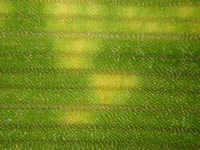
Figure 2 |
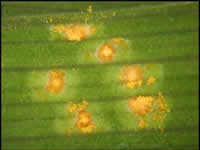
Figure 3 |
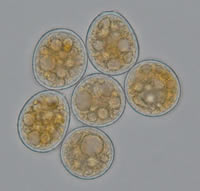
Figure 4 |

Figure 5 |
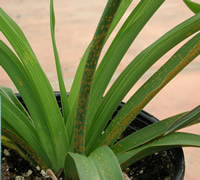
Figure 6 |
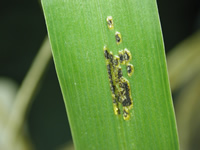
Figure 7 |
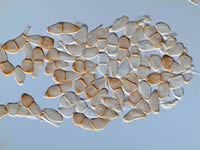
Figure 8 |
On Patrinia spp.:
Infection of Patrinia spp. by basidiospores (Figure 9) results in the formation of chlorotic, yellowish-green lesions on both leaf surfaces (Figure 10). Orange-yellow spermatia (pycniospores) are produced in structures called spermagonia within these lesions (Figure 11). The formation of spermatia is followed by the formation of structures called aecia on the lower surface of leaves. Within aecia, light yellow aeciospores are produced (Figure 12).
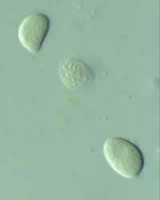
Figure 9 |
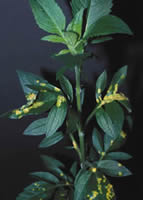
Figure 10 |
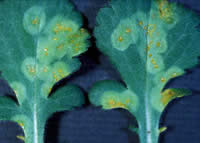
Figure 11 |

Figure 12 |
Pathogen Biology
Similar to other rust pathogens, P. hemerocallidis is an obligate parasite and requires a living host for growth and reproduction. P. hemerocallidis is a heteroecious fungus - two unrelated hosts are required to complete its life cycle (Figure 13). It is also considered a macrocylic rust because five different types of spores are produced in the complete life-cycle: spermatia (also called pycniospores) and aeciospores are produced on Patrinia spp., with aeciospores only able to infect daylily; urediniospores, and teliospores are produced on daylily, with teliospores producing basidiospores (Figure 9) that can only infect Patrinia spp..
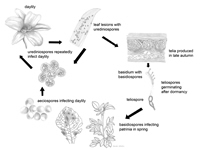
Figure 13
Differences between isolates of P. hemerocallidis in the ability to cause lesions on some cultivars of daylily suggest that genetic subdivisions termed “races” of P. hemerocallidis are present in the U.S. A race of the fungus carrying a non-virulent (or avirulent) gene would not be able to infect a daylily host with a corresponding gene for resistance but would cause disease on a daylily cultivar lacking this gene. Races are commonly reported in the rust pathogens that attack field crops such as wheat and barley – as new races emerge, corresponding resistance genes need to be moved into in the host genome by breeders to minimize disease losses. Interest in rust-resistant daylilies exploded after the rust entered the U.S. Since then, commercially important cultivars have been identified that are resistant to P. hemerocallidis.
Disease Cycle and Epidemiology
Patrinia is not widely planted in the U.S. and thus urediniospores from infected daylily plants are probably the only source of new infections on daylily each spring/summer. The thin-walled urediniospores (Figure 4) represent the ‘repeating stage’ of the disease – they are only capable of infecting leaves of the host plant species on which they are produced. This would include the infected plant and other nearby susceptible daylily plants. Urediniospores are prepackaged with everything necessary to infect the host plant – all that is needed is the presence of moisture to initiate spore germination. As a germ tube is produced, all the nuclear material travels from the spore down the germ tube prior to infection (Figure 14). Individual lesions can produce several thousand spores in a 24-h period and are capable of producing spores for several weeks until the leaf dies. Thus the amount of inoculum that can be produced is staggering.
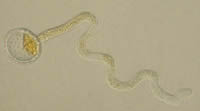
Figure 14
Low levels of disease often remain undetected until full-blown rust epidemics develop when environmental conditions are favorable. Growing conditions often contribute to the spread of daylily rust within nurseries: similar cultivars are aggregated in blocks and often tightly packed together (Figure 15). Natural dispersal of rust fungi is by wind: stem rust of wheat is an excellent example of a rust pathogen that is moved on prevailing southerly winds in spring northward from Mexico into the central Great Plains (see disease lesson on stem rust of wheat). Rust spores are light and easily carried by wind currents. Daylily rust inoculum (spores) is dispersed by wind within nurseries and also by overhead irrigation water (e.g. water splash), on workers clothes, or even by machinery. However, long-distance movement of P. hemerocallidis in the U.S. occurs primarily by truck rather than wind (Figure 16). Interstate movement of daylily is very common. The plants are mass produced by nurseries and shipped to different ornamental markets including "big–box" retailers. Hybridizers typically produce smaller quantities of plants but these are commonly shipped via truck to customers.
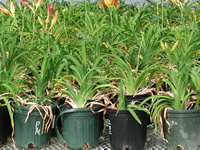
Figure 15 |

Figure 16 |
Environmental cues, typically the onset of colder weather in the fall, trigger the production of thick-walled, pigmented teliospores characterized by the appearance of blackish areas in the rust lesions (Figure 7). Teliospores allow the fungus to survive in the absence of the host – the only spore type capable of this. Once suitable environmental conditions occur – spring warm up – teliospores can germinate to produce the third spore type, basidiospores (Figure 8). These thin-walled spores are wind-blown to the alternate host, Patrinia, if present.
Daylily rust was initially detected in the southeastern U.S. in four states (AL, FL, GA, SC) in August of 2000. By January of 2003, the North American Phytosanitary Alert system indicated daylily rust had been officially reported in 23 states (AL, AR, CA, CT, DE, FL, GA, HI, IN, LA, MD, MI, MN, MS, NJ, NC, OH, OR, PA, SC, TN, VA, WI). Reports of daylily rust from three additional states (IL, KY, NY) have also been published. Internet searches added an additional nine states (IA, KS, MA, ME, MO, NH, NM, OK, TX) with unofficial reports of the disease (Figure 17). However, P. hemerocallidis does not survive well in areas that have extended periods of below-freezing temperatures. Typically daylily plants will die back to the crown with the first hard freeze (Figure 18) – any new infections the following year are presumably due to bringing in infected plants from warmer areas where the disease is established year-round. Daylily rust is currently endemic in the southern regions of the U.S. below USDA hardiness zone 7.
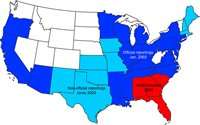
Figure 17 |
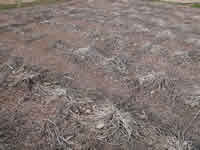
Figure 18 |
In Japan, daylily rust is commonly observed on wild Hemerocallis species. Similar to the situation in colder parts of the U.S., the fungus is not thought to overwinter successfully on daylily tissue. New infections on daylily in spring are presumed to be initiated by aeciospores produced on the alternate host, Patrinia. However, the spermogonial/aecial infection of Patrinia has rarely been observed in Japan.
Initially P. hemerocallidis was thought to infect hosta plants as well – another very popular ornamental landscape plant. If P. hemerocallidis had infected hosta, the eradication and quarantine costs for growers would have skyrocketed. The original descriptions of P. hemerocallidis listed hosta as a host; however, work in Japan was key in showing that a separate rust fungus, P. funkiae, was responsible for the hosta disease. P. funkiae does not cause disease on daylily.
Disease Management
Daylily rust caused widespread panic among daylily producers in the U.S. after it was initially detected in 2000. The presence of rust at a grower’s facility initially resulted in stop-sale orders by regulatory agencies – at large cost to growers. Many plants were destroyed in attempts to eradicate the fungus. Quarantines were used without success to limit the movement of the fungus throughout the U.S. However, the use of plant quarantines continues to be an important component of integrated pest management in the ornamental industry. It is important to realize that daylily rust can be introduced at any time to new areas on infected plants. New stock coming into a nursery should be kept separate from existing plants until the grower can be certain the new plants are disease-free. Scouting existing plants for symptoms and signs of rust is important for growers to initiate protective measures, such as fungicide applications, in a timely manner.
When daylily rust first entered the U.S. there were no registered fungicides to manage outbreaks and no scientific data on fungicide efficacy. Much data has since been collected and effective fungicides for the management of rust diseases are readily available. Restricted use fungicides are available for commercial growers that can be applied on 7-, 14-, 21- or 28-day schedules. Fungicides for home use can also be effective at limiting rust on daylily when applied before disease is established (preventatively).
The most effective management tool to limit losses to rust is to use disease-resistant cultivars. In traditional field crops, these are readily available for many serious rust pathogens. Resistance to the daylily rust fungus has been observed in some daylily cultivars. However, there are more than 71,000 registered daylily cultivars and the resistance to P. hemerocallidis of most is unknown.
In Japan, daylily rust is commonly observed on wild Hemerocallis species but rust outbreaks have not been reported for daylily cultivars on residential properties or public botanical gardens. It is unclear why the disease has not been problematic in Japan.
Significance
The U.S. Plant Protection Act of 2000 gives regulatory authorities “the ability to prohibit or restrict the importation, exportation, and the interstate movement of plants, plant products, certain biological control organisms, noxious weeds, and plant pests.” P. hemerocallidis was a quarantine-significant organism when it was detected in 2000. Regulatory agencies enforced eradication and quarantine measures to try to contain the fungus and then eliminate the organism from the U.S. These approaches have worked successfully for some rusts of ornamentals but failed for daylily rust. The North American Plant Protection Organization released an alert in 2003 ending the domestic quarantine of daylily rust. Several factors contributed to the rapid spread of daylily rust throughout the U.S.:
- the fungus is difficult to detect at ports-of-entry into the U.S. because much of the plant foliage is removed prior to shipping
- interstate movement of susceptible daylily species is common practice
- daylily is a very popular plant among hobbyists and hybridizers - movement of daylilies by these groups was not regulated
- few states had an effective quarantine in place
- adequate control measures for the disease were not initially available for growers
Daylily rust in an example of a quarantine that proved ineffective in the U.S. The fungus is now endemic to southern areas of the country.
Selected References
The American Hemerocallis Society http://www.daylilies.org/
The daylily rust information page http://www.daylilyrust.org/
Li, Y. H, M.T. Windham, R.N. Trigiano, D.C. Fare, J.M. Spiers, and W.E. Copes. 2007. Microscopic and macroscopic studies of the development of Puccinia hemerocallidis in resistant and susceptible daylily cultivars. Plant Dis. 91:664-668. http://dx.doi.org/10.1094/PDIS-91-6-0664
Mueller, D. S., J.L. Williams-Woodward, and J.W. Buck. 2003. Resistance of daylily cultivars to the daylily rust pathogen, Puccinia hemerocallidis. HortScience 38:1137-1140. http://hortsci.ashspublications.org/content/38/6/1137.full.pdf
North American Plant Protection organization phytosanitary alert system
http://www.pestalert.org/pestnewsdetails2.cfm?refID=77&keyword=daylily
Ono, Y. 2003. Does Puccinia hemerocallidis regularly host-alternate between Hemerocallis and Patrinia plants in Japan? J. Gen. Plant Pathol. 69:240-243. http://www.springerlink.com/content/nygw23enqq2chm6p/
The Plant Protection Act http://www.aphis.usda.gov/lpa/pubs/fsheet_faq_notice/fs_phproact.html
Wise, K.A., D.S. Mueller, and J.W. Buck. 2004. Quarantines and Ornamental Rusts. APSnet Features. Online. doi:10.1094/APSnetFeature-2004-0204
http://www.apsnet.org/publications/apsnetfeatures/Pages/OrnamentalRusts.aspx